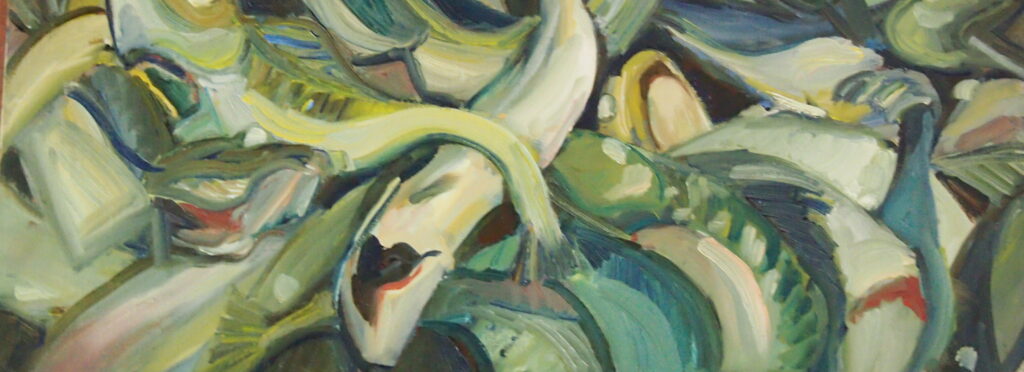I recently returned from 10 weeks of painting in Skagaströnd, in the North of Iceland. There are many canvases to unpack but for now I have this to share:
Every day In Skagaströnd fishing boats haul in staggering tons of cod and haddock. In the old days I am told there were even more and the fish were herring.
There was a fish factory, but the herring left and it closed.
Beginning in 2008, the village found a different use for the empty building. They call it Nes Artist Residency and I am grateful I could paint there alongside all kinds of marvelous artists.
How can a big open factory turn into a studio for a group of artists who don’ even know each other? To tell you the truth, I wasn’t sure it could. Those first days, I wanted walls around me. A door to shut. I tried to rig up a curtain, even a paper mache divider but nothing would let me hide away from all of these other artists.
Good thing. For I soon learned that the exposure to other people not so different from me was exactly what I needed. This very openness transformed me and let me participate in the transformation of that factory. You see, I came to realize it’s a continuous process. One that is not about the making or the doings, as much as the fish themselves. What they are and how they are caught and handled.
Herring boats no longer deposit fish out back. Now it’s the artists who must get the fish. Each one, alone hauls in her catch. How she does this, what she finds and how she handles the fish are the practices that turn the factory into a studio. They’re also the forces that, when all is said and done, make the art.
The big open space of Nes let me see how other artists fish. Some methods resemble my own practice, some pretty different. I learned it’s all okay. Maybe you sit in one place for a long while. Maybe you chase the aurora through the night or climb the mountain or walk a dog on the cliffs or listen to the ravens or the sea or the beep of a pay loader. You might grab a fish on the dark wind while coming to the studio very early, or find one sleeping on the beach among some animal bones. Maybe you’re talking to someone at a party and a fish swims straight from into your ear, or you’re at the computer and a whole school enters your eyes. Maybe you swallow fish in endless cups of tea and bowls of ramen noodles. Maybe you sleep and fish hang in the net of your dreams. It’s even possible that you find some piled with all the dead ones packed on ice at the harbor.
Which brings me to the next transformational force. These fish live. Caught. Sorted. Cut. Bleeding even. But they are not killed. They are magic fish. Handled with reverence and joy, they will change shapes before your very eyes. They will flip and flop all over that factory floor. Fish of many colors, many sizes. Ferocious ones. Shy ones. Funny ones. There are even fish that seem to disappear altogether, but somehow still move within the space they leave behind. 
Back here in Pennsylvania, there’s no lack of fish. And I’m catching them just as always. But now I know my methods –-even when they look a little crazy, seem pretty random– are okay. Maybe its the randomness that ushers in the marvelous. However it all works, I now know there are many others just like me –people who go fishing every day and work with industry and zeal and joy not to salt and barrel what they’e caught, but to let it live and move and feed us all.
Thank you Nes. Thank you to all the hospitable people of Skagaströnd and to the resident artists of January, February, and March 2013. If you want to read about the place or see the websites of the artists who have worked there, visit: http://neslist.is


